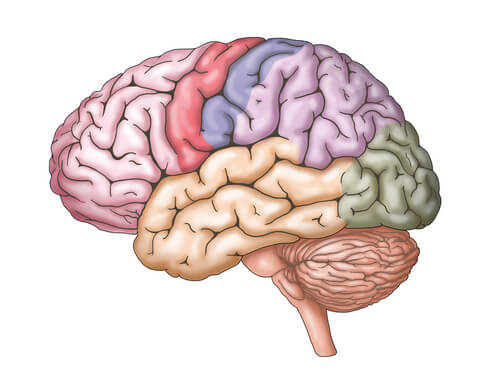The Cerebrum: Characteristics and Functions

The cerebrum is the largest anterior and superficial part of the brain. This structure is formed during the early stages of development. In fact, it emerges from the neural tube.
The cerebrum, also called the telencephalon, is above the diencephalon. It’s the highest integration center on a somatic and vegetative level. It’s divided into two hemispheres, the right and the left. They exchange information through the nerve fibers of the corpus callosum.
Thanks to the cerebrum, you have memory, emotions, and the senses of smell, sight, and taste, among other things. Let’s learn more about this surprising part of the brain!
How’s the cerebrum divided?
In addition to having two hemispheres, from an embryological and ontogenetic point of view, you can divide the cerebrum into the following parts:
- Firstly, the neocortex. This word means “new” or “recent” cortex. This is one of the most evolved regions of the cortex. Another name for it is isocortex. It’s made up of six horizontal layers.
- Paleocortex. This part of the cortex corresponds to the regions of the olfactory pathway endings.
- Arquicotex. Another name for it is the limbic lobe cortex. Scientists consider it the most ancient part of the cerebral cortex.
In addition, the outermost part of the two hemispheres is called the cerebral cortex. Scientists divide it into five lobes:
- Firstly, the frontal lobe. The frontal love is in the frontmost part of the brain. It’s responsible for the central information processing functions. Thanks to the frontal lobe, you’re able to carry out executive functions.
- Also, the parietal lobe. This lobe participates in recognizing and positioning sensory functions, as well as analytic and cognitive processes such as memory, calculation, and orientation.
- Occipital lobe. The occipital lobe perceives and analyzes visual information. This includes distances, sizes, light, position, and movement, among others.
- Likewise, the temporal lobe. This lobe is located near the ears. It’s the lobe with the most connections to the limbic system. Consequently, it’s an emotional area that’s also essential for memory.
- The insula. This structure is located in the Sylvian fissure (also called the lateral sulcus), where the temporal-parietal lobe and the frontal lobe meet. It plays a role in smell perception, visceral control, somatoperception, and emotional integration, among other things.

Structures in the cerebrum
In addition to the divisions we already discussed, other parts of the cerebrum are worth highlighting:
- Cerebral cortex. As we mentioned above, it’s divided into hemispheres and lobes, but also in layers that coordinate with each other. These include sensitivity, motor, and association areas that are in charge of perceiving and processing information.
- Cerebral amygdala. This structure is part of the limbic system. It’s responsible for your emotional reactions. Thanks to the amygdala, you’re able to escape from risk and danger. Also, it makes emotional learning possible.
- Hippocampus. The primary responsibilities of the hippocampus are memory consolidation and recall. It’s also in charge of orientation, the ability to learn new things and interpret your memories, and their relationship with your emotions.
- Olfactory bulb. Scientists believe that this is one of the most ancient parts of the vertebrate forebrain. Interestingly, animals have used it for tens of millions of years. It’s located in the lowest portion of the cerebral cortex. It processes information that comes from smell receptors.
- Corpus striatum. This is the primary entry pathway towards the basal ganglia. It plays a role in movement control, procedural memory processing, the focalization of attention, motivation, and the reward system.
Pathology of the cerebrum
Each part of the brain is fundamental for your survival and also complex and difficult to understand. Consequently, scientists still can’t completely explain some pathologies. For example, they still don’t know why they manifest or how to treat them.
The cerebrum can also suffer from some serious and complicated pathologies. Here are some pathologies that are related to the cerebrum:
- Schizophrenia. This is a mental disorder that causes the individual to perceive reality in a distorted way. Researchers continue to debate the causes of schizophrenia. However, one cause could be a malfunction in glutamate, a neurotransmitter that plays a role in your emotions and behavior.
- Depression. A mood disorder that causes a lack of energy, apathy, a propensity to crying, increased appetite or loss of appetite, and suicidal thoughts, among other things.
- Bipolar disorder. Patients with this mental disorder experience manic states or hypomanic states. They also suffer from major depression. This condition causes significant unhappiness for individuals who suffer from it, as well as the people in their lives.
- Parkinson’s disease. This illness affects movement coordination and causes cognitive decline. It can also cause depression and hyposmia, among other things. Researchers believe that the development of Parkinson’s is closely related to problems with the basal ganglia.

Scientific discoveries
Scientists have made great strides in understanding these pathologies and parts of the brain. A study published in Experimental Neurology by Laura Scott and collaborators suggests that autosomal recessive genes could be the key to understanding neurodegeneration in Parkinson’s patients.
An article published the same year (2018) in The World Journal of Biological Psychiatry also shared some important neuroscientific discoveries. This study proposed a relationship between the endocannabinoid system and schizophrenia. In this regard, the study analyzed how schizophrenia and bipolar disorder affected or didn’t affect sets of twins. The determining factor seemed to be hereditary abnormalities in the endocannabinoid system.
In conclusion, current neuroscience research is giving us new clues that will help scientists and doctors understand these disorders and treat them more effectively.
The cerebrum is the largest anterior and superficial part of the brain. This structure is formed during the early stages of development. In fact, it emerges from the neural tube.
The cerebrum, also called the telencephalon, is above the diencephalon. It’s the highest integration center on a somatic and vegetative level. It’s divided into two hemispheres, the right and the left. They exchange information through the nerve fibers of the corpus callosum.
Thanks to the cerebrum, you have memory, emotions, and the senses of smell, sight, and taste, among other things. Let’s learn more about this surprising part of the brain!
How’s the cerebrum divided?
In addition to having two hemispheres, from an embryological and ontogenetic point of view, you can divide the cerebrum into the following parts:
- Firstly, the neocortex. This word means “new” or “recent” cortex. This is one of the most evolved regions of the cortex. Another name for it is isocortex. It’s made up of six horizontal layers.
- Paleocortex. This part of the cortex corresponds to the regions of the olfactory pathway endings.
- Arquicotex. Another name for it is the limbic lobe cortex. Scientists consider it the most ancient part of the cerebral cortex.
In addition, the outermost part of the two hemispheres is called the cerebral cortex. Scientists divide it into five lobes:
- Firstly, the frontal lobe. The frontal love is in the frontmost part of the brain. It’s responsible for the central information processing functions. Thanks to the frontal lobe, you’re able to carry out executive functions.
- Also, the parietal lobe. This lobe participates in recognizing and positioning sensory functions, as well as analytic and cognitive processes such as memory, calculation, and orientation.
- Occipital lobe. The occipital lobe perceives and analyzes visual information. This includes distances, sizes, light, position, and movement, among others.
- Likewise, the temporal lobe. This lobe is located near the ears. It’s the lobe with the most connections to the limbic system. Consequently, it’s an emotional area that’s also essential for memory.
- The insula. This structure is located in the Sylvian fissure (also called the lateral sulcus), where the temporal-parietal lobe and the frontal lobe meet. It plays a role in smell perception, visceral control, somatoperception, and emotional integration, among other things.

Structures in the cerebrum
In addition to the divisions we already discussed, other parts of the cerebrum are worth highlighting:
- Cerebral cortex. As we mentioned above, it’s divided into hemispheres and lobes, but also in layers that coordinate with each other. These include sensitivity, motor, and association areas that are in charge of perceiving and processing information.
- Cerebral amygdala. This structure is part of the limbic system. It’s responsible for your emotional reactions. Thanks to the amygdala, you’re able to escape from risk and danger. Also, it makes emotional learning possible.
- Hippocampus. The primary responsibilities of the hippocampus are memory consolidation and recall. It’s also in charge of orientation, the ability to learn new things and interpret your memories, and their relationship with your emotions.
- Olfactory bulb. Scientists believe that this is one of the most ancient parts of the vertebrate forebrain. Interestingly, animals have used it for tens of millions of years. It’s located in the lowest portion of the cerebral cortex. It processes information that comes from smell receptors.
- Corpus striatum. This is the primary entry pathway towards the basal ganglia. It plays a role in movement control, procedural memory processing, the focalization of attention, motivation, and the reward system.
Pathology of the cerebrum
Each part of the brain is fundamental for your survival and also complex and difficult to understand. Consequently, scientists still can’t completely explain some pathologies. For example, they still don’t know why they manifest or how to treat them.
The cerebrum can also suffer from some serious and complicated pathologies. Here are some pathologies that are related to the cerebrum:
- Schizophrenia. This is a mental disorder that causes the individual to perceive reality in a distorted way. Researchers continue to debate the causes of schizophrenia. However, one cause could be a malfunction in glutamate, a neurotransmitter that plays a role in your emotions and behavior.
- Depression. A mood disorder that causes a lack of energy, apathy, a propensity to crying, increased appetite or loss of appetite, and suicidal thoughts, among other things.
- Bipolar disorder. Patients with this mental disorder experience manic states or hypomanic states. They also suffer from major depression. This condition causes significant unhappiness for individuals who suffer from it, as well as the people in their lives.
- Parkinson’s disease. This illness affects movement coordination and causes cognitive decline. It can also cause depression and hyposmia, among other things. Researchers believe that the development of Parkinson’s is closely related to problems with the basal ganglia.

Scientific discoveries
Scientists have made great strides in understanding these pathologies and parts of the brain. A study published in Experimental Neurology by Laura Scott and collaborators suggests that autosomal recessive genes could be the key to understanding neurodegeneration in Parkinson’s patients.
An article published the same year (2018) in The World Journal of Biological Psychiatry also shared some important neuroscientific discoveries. This study proposed a relationship between the endocannabinoid system and schizophrenia. In this regard, the study analyzed how schizophrenia and bipolar disorder affected or didn’t affect sets of twins. The determining factor seemed to be hereditary abnormalities in the endocannabinoid system.
In conclusion, current neuroscience research is giving us new clues that will help scientists and doctors understand these disorders and treat them more effectively.
This text is provided for informational purposes only and does not replace consultation with a professional. If in doubt, consult your specialist.







